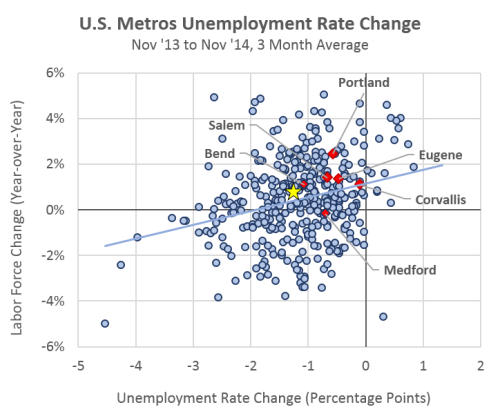![]()
By Josh Lehner
Oregon Office of Economic Analysis Blog
Like any individual economic measure, the unemployment rate is flawed. It can go down for bad reasons (people give up looking for work) and up for good reasons (more people looking for a job.) That’s why it is important to not just look at the unemployment rate itself, but the underlying components as well. As Danielle Kurtzleben notes over at Vox, the metros across the county with the largest unemployment rate declines are also losing labor force as well. Even if the number of jobs in the local economy remains flat, but more unemployed people drop out of the labor force, the unemployment rate goes down even though many would argue — myself included — that is not a signal that the economy improved. To get a better gauge of how pervasive these patterns are across the country, and here in Oregon, I plotted the latest data across all U.S. metros. The horizontal axis shows the unemployment rate decline over the past year, while the vertical axis shows the labor force change. There is quite a wide range of labor force behaviors for any given unemployment rate change, as seen in the graph.
 Broadly speaking, the metros best off are those in the upper left-hand quadrant. Their local unemployemnt rate is declining and they are adding to the labor force. That means that not only are more people looking for a job, possibly raising potential economic growth even further, but they are adding jobs at an even faster rate than they are adding people. 5 of Oregon’s 6 metros fall into this group, while Medford is just barely losing labor force over the past year. None of the state’s metros, nor the state for that matter, have seen as large of an unemployment rate decline as the nation overall (the yellow star) but we are also seeing larger labor force gains. To me, even though the economy is still not fully healed and likely won’t be for another couple years (more on this in the near future), the pattern of growth and the rate of growth is encouraging. The job growth acceleration of 2013 has held all through 2014 and we are seeing the labor force response (and population growth) that you would expect to have. All told, 2014 was a big improvement in the Oregon economy and the fundamentals are starting to exhibit their normal dynamics.
Broadly speaking, the metros best off are those in the upper left-hand quadrant. Their local unemployemnt rate is declining and they are adding to the labor force. That means that not only are more people looking for a job, possibly raising potential economic growth even further, but they are adding jobs at an even faster rate than they are adding people. 5 of Oregon’s 6 metros fall into this group, while Medford is just barely losing labor force over the past year. None of the state’s metros, nor the state for that matter, have seen as large of an unemployment rate decline as the nation overall (the yellow star) but we are also seeing larger labor force gains. To me, even though the economy is still not fully healed and likely won’t be for another couple years (more on this in the near future), the pattern of growth and the rate of growth is encouraging. The job growth acceleration of 2013 has held all through 2014 and we are seeing the labor force response (and population growth) that you would expect to have. All told, 2014 was a big improvement in the Oregon economy and the fundamentals are starting to exhibit their normal dynamics.
Lastly, the worst outlier down in the right-hand corner is Atlantic City where the labor force cratered nearly 5 percent year-over-year and the unemployment rate still rose 0.3 percentage points. Given the ongoing struggles with the gaming industry (see our report) there is at least a plausible story to tell for Atlantic City.
Disclaimer: Articles featured on Oregon Report are the creation, responsibility and opinion of the authoring individual or organization which is featured at the top of every article.

